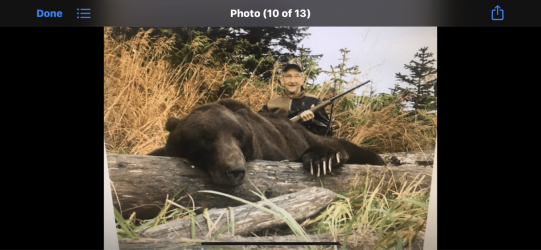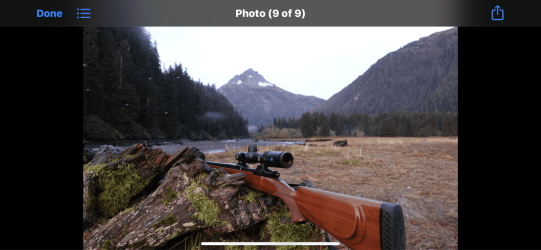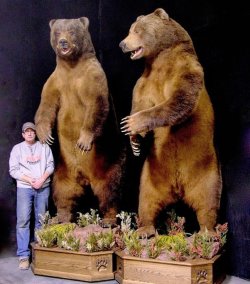Haven't hunted bears, but have hunted a lot of animals in Africa and a monolithic from a .375 Ruger that hits in anywhere in the vital zone puts the animal down right there or within 10 yards; a hit outside the vital zone -- even far outside the vital zone -- slows them down quite a bit and allows a follow-up shot to finish the job. A suboptimal hit from smaller calibers always puts the animals to flight -- always. If you're lucky, you may find them later and get another shot, but very often you won't, even with the services of a skilled tracker.But they don't require multiple shots. I've never had to do a follow up on a moose or a sheep or a bou except with monos. Mono's are slow killers IME. And not 22 mono's. 7s, 30s, 33s. Heavy for caliber lead bullets that are above their minimum velocity upon impact, placed anywhere in the vitals kill no matter the caliber, no matter the animal.
This is because animals don't wear body armor. All north American animals are rather thin skinned. Preditors even more so. Thinner bones to.
If you've looked at moose vs bear bones and hide density and thickness you know the bear has less of both. This is the case for all prey vs predator animals.
The only animals I shoot more than once are bears that need to die where they stand, but that'd be the case for any cartridge.
A 375 ruger into the lungs of a brown bear doesn't kill it any more quickly than a 223 in the same location. Or if if does its irrelevant because in both instances you're tracking that bear. It's not a DRT.
So why not shoot it with the rifle and caliber you can more likely get the cns hit and stay in the scope and on target for the immediate follow ups going for that cns hit?
-
If you are being asked to change your password, and unsure how to do it, follow these instructions. Click here
You are using an out of date browser. It may not display this or other websites correctly.
You should upgrade or use an alternative browser.
You should upgrade or use an alternative browser.
Brown bear Rifle
- Thread starter zeeman
- Start date
 Help Support Long Range Hunting Forum
Help Support Long Range Hunting Forum
My friend that I mentioned earlier in this thread carried a 416 Rem at the recommendation of his guide. He already had a 375 and a 500 Gibbs double but they insisted on the 416.
Long story short he killed a nice,heavy, 9'7" brown bear about 3 weeks ago. The bear was quartered away slightly at 118 yards. The bullet, handloaded, I wish I knew exactly what it was, was beautifully mushroomed. The bullet had fine horizontal lines all the way up the shank. He shot the bear through the ribs and the bullet came to rest under the hide after breaking the far side shoulder. He was basically dead on his feet and made it 48 yards before going down hard. Elapsed time around 5-6 seconds. His guide was a lady named Mutt. He's hunted a lot of places and has done some outfitting in Africa. He said Mutt skinned all 3 bears taken that week and was one helluva guide. Some of you may have hunted with her before.
Long story short he killed a nice,heavy, 9'7" brown bear about 3 weeks ago. The bear was quartered away slightly at 118 yards. The bullet, handloaded, I wish I knew exactly what it was, was beautifully mushroomed. The bullet had fine horizontal lines all the way up the shank. He shot the bear through the ribs and the bullet came to rest under the hide after breaking the far side shoulder. He was basically dead on his feet and made it 48 yards before going down hard. Elapsed time around 5-6 seconds. His guide was a lady named Mutt. He's hunted a lot of places and has done some outfitting in Africa. He said Mutt skinned all 3 bears taken that week and was one helluva guide. Some of you may have hunted with her before.
HARPERC
Well-Known Member
Always wanted to hunt with them. Lot of video over time looks like a great outfit.Elapsed time around 5-6 seconds. His guide was a lady named Mutt. He's hunted a lot of places and has done some outfitting in Africa. He said Mutt skinned all 3 bears taken that week and was one helluva guide. Some of you may have hunted with her before.
He went on a boat hunt with them last year. Saw a lot of bears just couldn't put it all together. Mainly hunting salmon streams then. He's in his 70s but in great shape. He said that was one grueling hunt.Always wanted to hunt with them. Lot of video over time looks like a great outfit.
I found this a bit difficult to believe but this guy is honest as the day is long. He's basically killed every African species there is and actually darted a Rhino. He said 3 bears were taken that week. His was with 1 shot. A second customers took 5 shots. And a third took 12 shots! Crazy
HARPERC
Well-Known Member
Unlikely! When I first became aware of Glacier Guides was a video, they pressed .375 and up, even for Black Bear. In addition with low light capable optics.We're either of the other two hunters shooting the Johnny-come-lately 223 Remington cartridge?
Hahaha... just kidding.
The Dad seems to have retired, and maybe their stance has changed.
Black Bear $15,000 Brown Bear $40-61,000.
Animals hit count as bagged.
Last edited:
Smart on their part. Why take the increased risk of a wounded bear, and your guide having to risk his life on the followup retrieval effort.Unlikely! When I first became aware of Glacier Guides was a video, they pressed .375 and up, even for Black Bear.
From what I understand they were just that shook up and that bad at shooting. With the 12 shots the guide was shooting also.Were either of the other two hunters shooting the Johnny-come-lately 223 Remington cartridge?
Hahaha... just kidding.
The bullet my friend used appeared to be a North Fork Soft Point. Small horizontal lines in the base. Huge mushroom. I haven't asked him that yet but I saw the bullet.
I am of the opinion that the 223 cartridge is excellent. For Squirrels
If they will allow you to hunt with the 300 wm than by all means DO SO. But if they don't then you need to make a decision on what you want that you probably never will be used againPlanning on a once in a lifetime brown bear Alaskan hunt in a couple years. Have a 300 Win Mag that shoots 220 Nosler partitions and 200 Nosler partitions quite well. Don't really want to buy another rifle but should I move up to a 338 class? Thinking of either a 33 Nosler, 338 WM or 338 ultra??? Opinions???
I have a dear old friend who got the once in a lifetime opportunity to go on a brown bear hunt and all the amenities except the Guide required a 375 H&H or larger and they had rifles to rent so to speak but that was 2k extra so John borrowed my old Whitworth Interarms Mauser and we put a 1-6x24 Zeiss optic on it.I worked on a load all summer but settled in on a classic 300grain Swift A-frame and a big spoon full of Imr and the rest is history as they say
Attachments
Just curious, how many rounds would you say your friend fired through that Mauser prior to conducting his hunt and what were the conditions for that range time?If they will allow you to hunt with the 300 wm than by all means DO SO. But if they don't then you need to make a decision on what you want that you probably never will be used again
I have a dear old friend who got the once in a lifetime opportunity to go on a brown bear hunt and all the amenities except the Guide required a 375 H&H or larger and they had rifles to rent so to speak but that was 2k extra so John borrowed my old Whitworth Interarms Mauser and we put a 1-6x24 Zeiss optic on it.I worked on a load all summer but settled in on a classic 300grain Swift A-frame and a big spoon full of Imr and the rest is history as they say
Congrats on the success by the way!
PhilMW
Member
Some replies mentioned the guide carrying a .375 as backup ~ there's a reason for that ...Planning on a once in a lifetime brown bear Alaskan hunt in a couple years. Have a 300 Win Mag that shoots 220 Nosler partitions and 200 Nosler partitions quite well. Don't really want to buy another rifle but should I move up to a 338 class? Thinking of either a 33 Nosler, 338 WM or 338 ultra??? Opinions???
Grizzly and Brown Bear can weigh in at over 1600 pounds and run 35 to 40 miles an hour ~ these monsters are hunters ~ they will track you, circle around behind you and bust out of the brush from nowhere, showing off their finest sprint.
Ruger Hawkeye Guide Gun in 375 or 416 Ruger is a safe choice.
Heavy 20" S/S barrel w/muzzle break and Laminated stock. Great Brush gun that'll take the harsh weather and get the job done...
... runs in the 1100 - $1200 range
Leave the smaller calibers to the the macho guys that don't mind ****ing-off 1600 pound meat eaters
Personally, I wouldn't want my once in a lifetime bear hunt end up the last thing I did in my lifetime.
PhilMW
Planning on a once in a lifetime brown bear Alaskan hunt in a couple years. Have a 300 Win Mag that shoots 220 Nosler partitions and 200 Nosler partitions quite well. Don't really want to buy another rifle but should I move up to a 338 class? Thinking of either a 33 Nosler, 338 WM or 338 ultra??? Opinions???
Attachments
PhilMW
Member
Planning on a once in a lifetime brown bear Alaskan hunt in a couple years. Have a 300 Win Mag that shoots 220 Nosler partitions and 200 Nosler partitions quite well. Don't really want to buy another rifle but should I move up to a 338 class? Thinking of either a 33 Nosler, 338 WM or 338 ultra??? Opinions???
... mmmmm chewy on the outside, goooy on the inside ~ hea, this one had steak'n eggs fer breakfast.Some replies mentioned the guide carrying a .375 as backup ~ there's a reason for that ...
Grizzly and Brown Bear can weigh in at over 1600 pounds and run 35 to 40 miles an hour ~ these monsters are hunters ~ they will track you, circle around behind you and bust out of the brush from nowhere, showing off their finest sprint.
Ruger Hawkeye Guide Gun in 375 or 416 Ruger is a safe choice.
Heavy 20" S/S barrel w/muzzle break and Laminated stock. Great Brush gun that'll take the harsh weather and get the job done...
... runs in the 1100 - $1200 range
Leave the smaller calibers to the the macho guys that don't mind ****ing-off 1600 pound meat eaters️
Personally, I wouldn't want my once in a lifetime bear hunt end up the last thing I did in my lifetime.
PhilMW
Some replies mentioned the guide carrying a .375 as backup ~ there's a reason for that ...
Grizzly and Brown Bear can weigh in at over 1600 pounds and run 35 to 40 miles an hour ~ these monsters are hunters ~ they will track you, circle around behind you and bust out of the brush from nowhere, showing off their finest sprint.
Ruger Hawkeye Guide Gun in 375 or 416 Ruger is a safe choice.
Heavy 20" S/S barrel w/muzzle break and Laminated stock. Great Brush gun that'll take the harsh weather and get the job done...
... runs in the 1100 - $1200 range
Leave the smaller calibers to the the macho guys that don't mind ****ing-off 1600 pound meat eaters️
Personally, I wouldn't want my once in a lifetime bear hunt end up the last thing I did in my lifetime.
PhilMW



